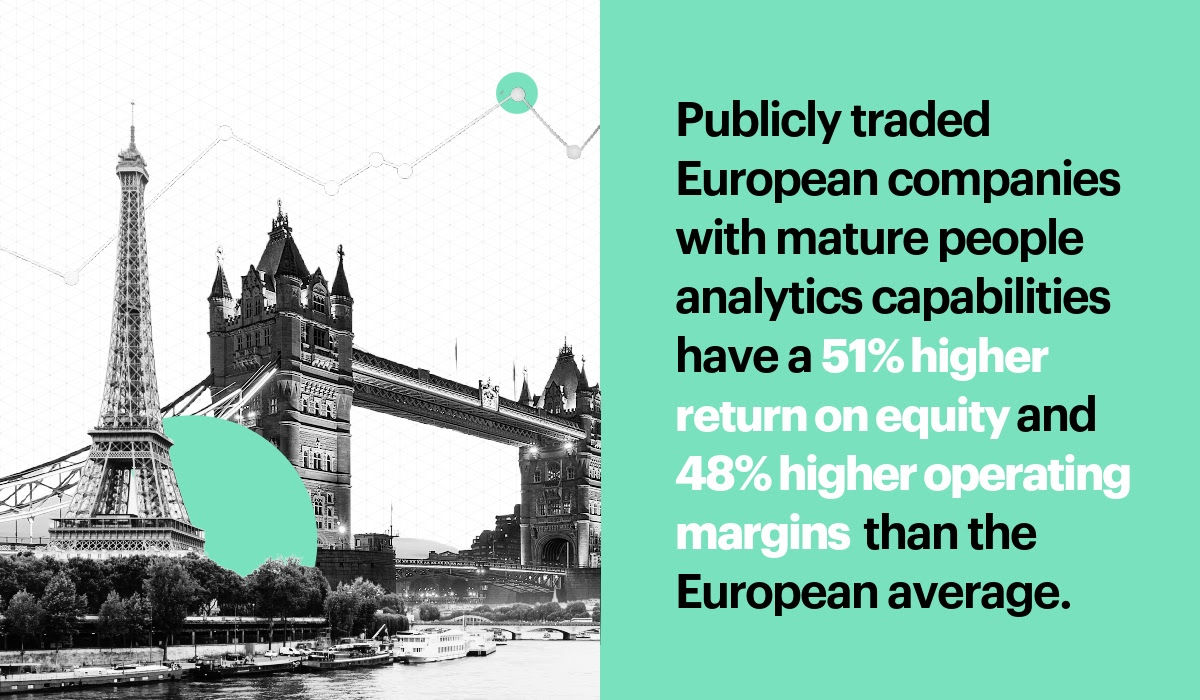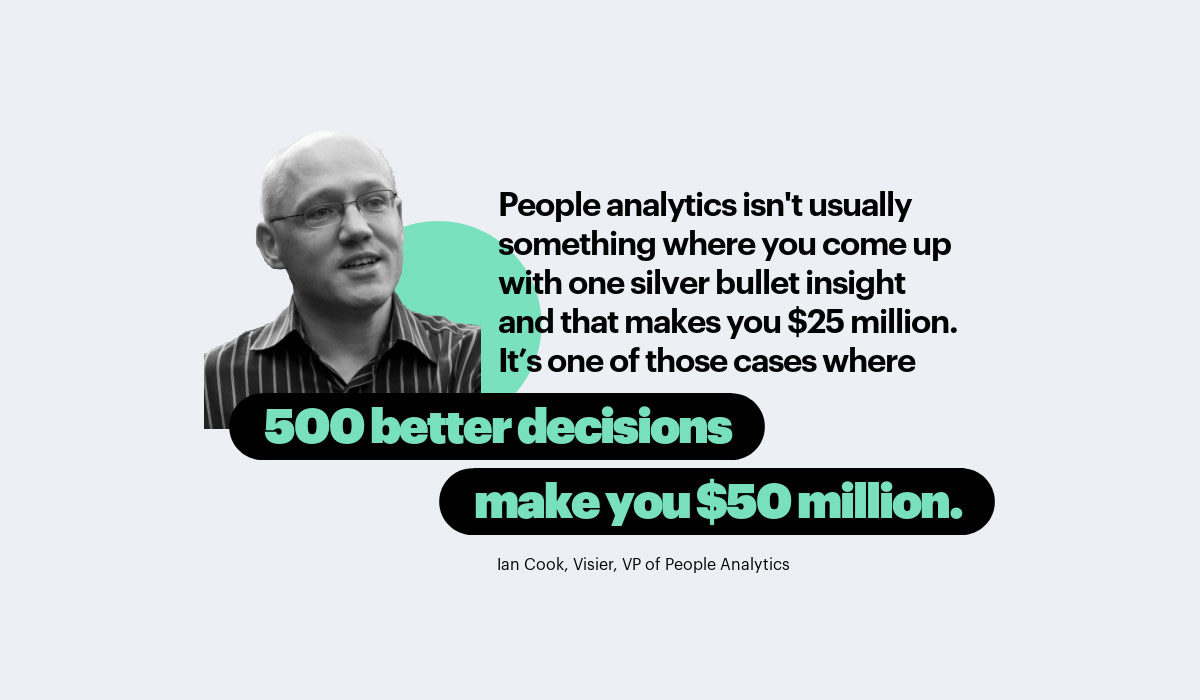3 Ways to Succeed with People Analytics, According to New Survey
A new European survey revealed three massive opportunities for people analytics–and expert-driven tips for how best to progress in each area.

This article was jointly written by Visier team members Stephen Haigh, a Client Account Executive, and Paul Atkins, a Project Manager.
People analytics has shifted from fringe practice for pioneers to established best practice, with a decade’s worth of compelling evidence proving value. For example, publicly traded European companies with mature people analytics capabilities have a 51% higher return on equity and 48% higher operating margins than the European average.

But what are HR and business leaders most focussed on over the next 12-18 months? We asked attendees at our recent fireside chat with Uber’s Head of People Analytics, RJ Milnor, to weigh in and they identified three massive opportunities for people analytics. We share their answers below alongside Visier experts’ perspectives, to explore how best to progress in each area.
1. Put data into the hands of daily decision makers
It’s heartening to see 39% of respondents identify democratising data as their biggest area of opportunity, given the value of people analytics rests on this capability. As Mike Everitt, Senior Solutions Consultant at Visier, points out, “The failure in the past to successfully share meaningful insights with the business is a primary reason so many traditional BI projects have failed.”
Analytics has typically been siloed in specialist teams, with requirements thrown over the wall to data scientists with the skills to extract insight. That’s a problem because:
It’s too far from the point of need, so analysts lack on-the-ground context to guide and prioritise questions.
It’s inherently hard to scale because your data scientists become gatekeepers to insight.
It’s too slow for the pace of business today; insights are outdated before you’ve even extracted them.
Data becomes much more valuable when you dissolve silos and make data accessible without specialist skills, giving ownership to decentralised decision-makers.
“The ideal state is for business unit and department leaders to have constant access to key insights about their people and teams that improves their capacity to deliver results,” says Ian Cook, Visier’s VP of People Analytics. “For example, understanding which high-performing salespeople are at-risk of leaving and taking action to address.”
Democratising data means empowering people who make decisions daily to do so better and faster–to fuel stronger people and financial outcomes. As Ian said during his Outsmart session, Answers at Scale: The Third Wave of People Analytics, “People analytics isn’t usually something where you come up with one silver bullet insight and that makes you $25 million. It’s one of those cases where 500 better decisions make you $50 million.”

That’s about much more than sharing metrics on a dashboard. “Sticking a dashboard in front of a manager and expecting them to know what it means, why it’s important, and what they should do with it is unlikely to generate adoption or aid decision making,” adds Mike.
The reality is that democratising data is a process and cultural challenge as much as a technical one. Yes, you need the right technology and easy-to-use dashboards. But also, you need an engaging user experience, so people want to participate. You need Business Partner champions who are hungry for insights and excited to explore and discover. And you need to guide them to the right answers, making sure they’re supported through every step of their analytics journey.
2. Carve out a competitive edge
Given the last 18-months’ extreme disruption, it’s no surprise 37% of leaders see improving business performance as their major people analytics opportunity.
We’ve had evidence for a decade now that people analytics doesn’t just drive better people outcomes; it drives concrete business value. At Outsmart, Ian spoke about how attitudes have evolved to truly understand, “we need to find a way to help our people thrive, so the business can thrive. The thing that makes people really difficult is, they can choose how well you perform.”
An IDC whitepaper found organisations with mature people analytics achieved 293% five-year ROI, 20% increase in HR efficiency, 9% lower turnover and 16% faster time-to-market. They also reduced operational expenses by $79,000 and gained an additional $285,700 revenue.
But let’s talk about how you get there: “Don’t take the typical HR approach of trying to provide for everyone at once,” Ian warns. “These projects work best when they’re tied to a key project or growth area. Drill down and over-invest time and resources to ensure you deliver a result. Then you’ll find other business unit leaders lining up for your support.”
“Most organisations start in the wrong place with people analytics,” Mike echoes. “They start with mountains of data, spending many months, often years, trying to stitch it together to an appropriate data model. Then they finally begin answering questions from HR, leaders, and the rest of the business.”
This model stalls progress, damages buy-in, breeds cynicism and ultimately makes the broad, democratic participation we talked about above more difficult. That’s a death warrant for effective people analytics that drives business value.
Instead, Mike says, “Turn that model on its head. Focus on a narrow problem and dataset, to start providing value extremely early.”
For example, when we asked European HR and business leaders about their biggest focus areas for people analytics, building critical skills topped the list (with workforce planning, organisation design, and employee experience following close behind).
This incremental, focussed approach grows your impact to drive performance improvement at scale.
3. Adopt or accelerate people analytics
More than a fifth of respondents identified the need to either adopt or accelerate their people analytics agenda. That’s testament to the fact there’s never been a more urgent need for people analytics.
Organisations already equipped when the pandemic hit were better placed to evolve with agility, proving value and galvanizing support to scale. Organisations that weren’t where they wanted have seen the point brought forcefully home.
Ian explains how the pandemic has “radically changed our focus on people”, as practically overnight “people across the business became completely dependent on people data to make decisions day-to-day.” Moving forwards, people analytics has become a pivotal strategic business capability. Says Ian, “how we work has permanently altered. Trying to run an organisation today without a detailed and distributed understanding of your people will mean you’ll fall behind the competition”.
There’s also never been a better time to build momentum. “Now is the time to act on your people analytics priorities because there’s an established, easy-to-follow path to success and business leaders willing to make the needed investment to get there,” Ian concludes.
Your next steps depend on the tools you use now. The ability to automate and scale are the two critical enablers of people analytics–so you’ll need technology that empowers both.
You won’t get there with spreadsheets. As one American financial services organisation discovered, spreadsheets are too manual, too time-consuming, too error-prone, and too slow to facilitate the on-demand decision-making people analytics success hinges on.
It won’t likely be your existing HR tools either. Migrating your HRMS to the cloud won’t achieve true transformation because it only relocates fundamentally backwards-looking, static data. “People analytics technology is fundamentally different to the technology that supports your HR systems,” says Visier’s Director of Product Marketing, Caitlin Bigsby. “People analytics is a critical piece of technology that spins data points into insights. It takes all your pieces of data from across systems, mixing them together, processing them and transforming them into information you can work with”.
Traditional BI tools could work but often don’t. As Mike talked about above, the value from people analytics comes when you put data into the hands of everyday decision-makers – and you act fast, taking an incremental approach to scale value. Most BI projects fall at both hurdles.
In practice, automating and scaling forward-looking insights demands a built-for-purpose people analytics platform. So the question becomes whether your goals are best-served by building or buying this technology.
“We decided we could build what we need–but we’ve got a great solution on the market already with Visier. It made more sense to use our own resources to do things that truly differentiate,” Uber’s Head of People Analytics, RJ Milnor, says. ”Plus, building might take a year versus being live in under two months. I want to spend time not having insights sit on the shelf, but getting actionability as quickly as possible.”
An exhilarating time for people analytics progress
The people analytics space is unrecognisable from a decade ago, seeing analytics move from a fringe activity for only the most innovative and pioneering organisations into established best practice for all.
That said, if you’re not where you’d like with people analytics yet, don’t rush headlong into a program that takes years to deliver value (if ever). Instead, target incremental gains through measurable, managed progress.
Get Outsmart content straight to your inbox
Subscribe to the People Insights Monthly newsletter for actionable insights and stories.
Subscribe now